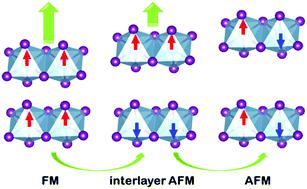Magnetic and electronic properties of 2D TiX3 (X = F, Cl, Br and I)†
Abstract
Searching for two-dimensional (2D) materials with a high phase-transition temperature and magnetic anisotropy is critical to the development of spintronics. Herein, we investigate the electronic and magnetic properties of 2D TiX3 (X = F, Cl, Br and I) monolayers based on density-functional theory (DFT). We show that the 2D TiX3 monolayers are stable dynamically and thermodynamically as evidenced by phonon and molecular dynamics calculations, respectively, and show their semiconducting nature. We find that the TiBr3 and TiI3 monolayers are ferromagnetic with magnetic anisotropy out of plane, which are intrinsic without the need for external intervention. The magnetic anisotropy energies of the TiBr3 and TiI3 monolayers are 0.8 and 2.5 meV per s.f., respectively. The Curie temperatures of TiBr3 and TiI3 are 75 K and 90 K, respectively. We further show that the interlayer magnetic coupling and magnetic anisotropy energies (MAE) of the bilayer TiI3 can be tuned by the interlayer distance. Additionally, a two-step transition in the magnetic state is observed in the bilayer TiI3 with AB′ stacking under applied strain in a vertical direction. It is expected that our design may enrich two-dimensional functional materials, which may find versatile applications.



 Please wait while we load your content...
Please wait while we load your content...